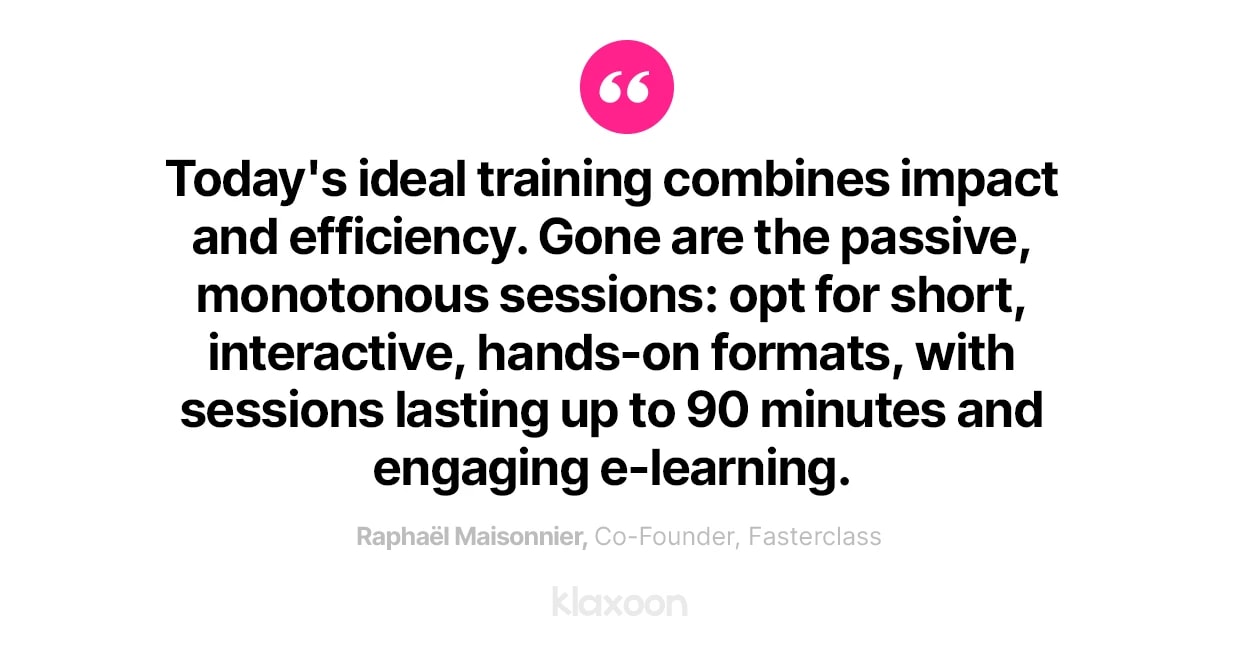How can project management make your corporate training program more effective? (with 3 proven strategies)
Published on July 30, 2025
How can project management make your corporate training program more effective? (with 3 proven strategies)
According to a LinkedIn study, only 4% of large-scale corporate training programs reach the stage of results evaluation. At a time when skills development is emerging as a strategic lever for organizations, this figure reveals the limitations of traditional approaches.
Today, trainers and L&D teams are operating in a difficult context: restricted training budgets, rapid obsolescence of skills, growing need for personalization, the need to adapt quickly to new technologies, etc. In the face of these challenges, existing solutions are struggling to meet expectations.
What if it was time for a new approach?
One way of offering effective training in these conditions is to get inspired from project management. This approach is structured, requires little extra spending, and has already been successfully applied in many fields.
In project mode, L&D teams can :
In this guide, we also look at 3 effective project management strategies that can be transposed to training:


In an environment where skills have become the main driving force behind organizations, corporate training has never been so highly valued. And yet, in 2024, 68% of employees admit to having missed out on training due to lack of time (iSpring).
This reflects a paradoxical and difficult context for training professionals and L&D (Learning & Development) teams, for whom the challenges are multiplying:
What if the key to effectively meeting all these challenges lay in the principles of project management?
Project management is now everywhere in organizations, and is already used in many functions, often informally. What's more, this approach does not require advanced expertise to be applied in the field of corporate training.


Now let's take a look at how strategies usually used in project management can also improve the performance of your next corporate training program, and enable you to concretely assess its ROI.
One-size-fits-all training became increasingly popular during the 2020 pandemic. These are mass training programs, often digitized, that organizations set up to train large numbers of employees at once.
While this approach was highly beneficial at the time, it is now reaching its limits. In 2024, 89% of learners are looking for personalization in their training opportunities (CYPHER Learning).
This means that companies need to rethink their approach to training to make their actions more effective. Many needs can be met through microlearning, with content that is often highly personalized, flexible and, above all, fully integrated into the continuity of teams' work.
In the field of corporate training, the quest for personalization is driving the diversification of learning formats. Although no scientific study has proven the effectiveness of training using different learning styles, varying methods according to needs and objectives remains essential in practice to maximize the impact of training.
Today, companies often favor e-learning, mainly for budgetary reasons. However, training organizations are placing greater emphasis on face-to-face sessions, perceived as more engaging.
The trend, however, is towards an intermediate solution: blended learning. By combining different digital learning formats with face-to-face sessions whenever possible, this approach makes it easier to adapt training content to learners' needs.


Artificial intelligence (AI) is redefining the way people work and learn, but it is also raising new challenges.
On the corporate side, interest in AI is undeniable, but concrete actions to facilitate its adoption remain limited, due to budgetary constraints and a still emerging training offer.
This is due to the extremely rapid evolution of technologies, which makes certain tools and skills rapidly obsolete (2 years on average for a technical skill), and requires training organizations to constantly adapt to keep pace.
To do just that, they are also increasingly relying on AI-based tools. As a result, they are creating new training content faster (which accounts for an average of 53% of their time, according to HubSpot), and spending less time on repetitive tasks linked to organization and planning. Some go even further, integrating AI coach profiles into their learning paths.
In addition to a lack of alignment between the training offered in-house and actual needs, the workload demanded of employees alongside training continues to increase. As a result, they don't have the time they need to invest fully, and 68% had to miss a training course in 2024 for this reason (iSpring).
What's more, many companies still see training as a one-and-done event: once the training action has been completed, the skill is considered to have been acquired once and for all.
However, for learning to be effective and engaging, information must be assimilated and put into practice over time, through spaced repetition. According to HBR, if we don't apply what we have learned within 6 days, we will forget up to 75% of it!
Finally, training is not always the best way of solving a business problem, for example, when it concerns communication or collaboration. In such cases, management needs to be careful in identifying the moments when training will be really necessary and effective in positively impacting a situation.
Today, more than ever, companies want to measure the precise impact of training on employee performance and results. This data-driven approach is becoming increasingly important for L&D teams, who need to go beyond vanity metrics (number of participants, learner satisfaction, etc.), and establish a clear link between training actions and team efficiency, or even company revenues.
Moreover, this impact needs to be measured quickly, due to the obsolescence of skills. Yet, according to LinkedIn, many large-scale corporate training programs take a very long time to roll out, with only 4% reaching the final stage of evaluating results.
What's more, companies also have to take into account limited budgets and rising costs. As a result, many companies prefer to train their employees on-the-job, i.e. while carrying out their tasks with the help of their peers. However, the impact of this type of learning is difficult to measure clearly, and it is only effective if it has clear objectives, tackles the problem from the right angle, and involves management in the process to encourage adoption of the desired behaviors.
As we have seen, traditional approaches are no longer sufficient to meet today's corporate training challenges: optimizing resources, controlling budgets, and measurably impacting team performance.
And yet, acquiring new skills has become an essential strategic lever for an organization's success, particularly in terms of developing employees' careers and building loyalty.


With over 60% of companies acknowledging that they lack key skills for their business (World Economic Forum), it becomes important to find a new approach to help them meet their needs effectively.
One of the most promising solutions is to draw inspiration from project management practices. Today, teams are increasingly adopting a structured, collaborative approach to project work. This approach has proved its worth in other fields, and can also be easily applied to corporate training, with numerous benefits:
For 53% of trainers, content creation is the most time-consuming step (HubSpot). Then there are the administrative tasks: organizing sessions, communicating about training and managing registrations. To optimize these processes, many professionals rely on specialized tools such as LMSs, CRMs or, as mentioned above, AI.
However, these tools are not always sufficient to strategically structure the entire training path. This is where a project-based approach makes all the difference in :
In this way, you create a structured framework that clearly meets the company's needs, without requiring a substantial budget. Furthermore, it enables you to offer more than a one-and-done corporate training program, which has little impact in terms of pedagogy and ROI, and to directly measure the value it brings to the business.


The SMART Goals method, often used at the beginning of a project, can also be used to define training objectives.
A strong learning culture is a powerful lever for companies: according to LinkedIn, it increases employee retention by 57%, and strengthens their sense of belonging for 7 out of 10 employees.
The project-based approach structures exchanges and engages all stakeholders before, during and after training (employees, trainers and managers alike). At each stage, collaboration flows seamlessly towards the learning objective defined upstream. This approach promotes transparent communication, simplifies coordination, and strengthens learner engagement.
Given the rapid transformation of training needs in line with skills, technologies and business priorities, a project-based approach also enables L&D teams to adapt better, thanks to rapid iteration cycles:
Finally, a project-based approach is a good way of assessing the effectiveness of a corporate training program. It provides a clear overview of the skills actually acquired and applied by learners. What's more, it makes it possible to link them directly to organizational performance, thus highlighting the return on investment of training actions.
Thanks to this method, L&D teams can go beyond traditional indicators and define results-oriented KPIs, aligned with strategic objectives:
Inspired by Lean Management, Lean Learning consists in optimizing the learning process as much as possible. This approach combines various methods that reduce superfluous elements, and focus on strategic aspects for the business:


With the 8D method, you can refine your understanding of a problem related to a training program and propose effective solutions.
Based on the same principle as Lean Learning, Agile Learning draws on the principles of agile project management to segment the learning path into short, iterative modules (or sprints), with each sprint having a concrete, measurable learning objective.
Another project management methodology that applies well to corporate training is design thinking. In product design, this approach aims to create a product centered on the user, by directly involving the latter right from the prototype and initial tests.
In training, your learning path can play the part of the product to be created:


Mind mapping is an excellent tool for thinking about everything involved in acquiring a training skill.
Applying Lean Learning, Agile Learning or design thinking to corporate training is an effective solution to the current challenges facing companies and L&D experts. This simple approach will optimize your resources, improve learner engagement, and generate a measurable impact on your business performance.
To move effectively into project mode, you need the right tools. A project management platform, combined with ready-to-use methods like Klaxoon's templates, can transform your training practices to make them more dynamic, interactive and aligned with all your expectations.
Unlock your teamwork potential